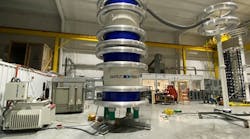PCORE test terminals allow utilities to perform field dielectric tests of substation equipment such as transformers and circuit breakers quickly, safely and cost-effectively. Utilities worldwide are turning to regular field testing as a means of extending the service life of existing equipment.
The test terminal functions as an electrical switch permanently connected in series between the power bus and the equipment to be tested, eliminating the need to physically remove the power bus during testing.
In the closed position, the test terminal permits electrical power to be transferred from the power bus to the equipment. When you wish to test the equipment, you first de-energize the power bus. Then you back off the four captive bolts at the top of the test terminal and loosen the four bottom bolts to let the terminal’s blades swing out in an open position. With the bus grounded, the equipment is now isolated from the power bus and you may perform standard dielectric tests.
During testing, the equipment is energized by the high-voltage cable from the Doble test set, and the center casting of the terminal is connected to the test set’s “guard” so any stray leakage current is bypassed and returned to the test set without being measured.
Loosening and tightening the bolts on the test terminal and connecting the terminal to the test set takes only a matter of minutes. What’s more, depending on the equipment you’re testing and its location, testing can often be accomplished without a boom or bucket truck, or extra personnel. By reducing boom & bucket truck time by up to 60% for the typical maintenance interval you eliminate some safety risk to your employees and save thousands of dollars per outage. Additionally, because the test terminal makes it possible to isolate virtually any substation equipment from its power bus, without having to physically remove the power bus, it eliminates the risk of equipment damage associated with other testing methods.
By extending the service life of existing substation equipment without performing periodic field tests, you face the risk of that equipment failing electrically, resulting in expensive downtime, lost revenue, and costly repair & replacement. On the other hand, if you perform regular field tests without test terminals, your testing costs can be significant. Because the test terminal makes it so easy to test your substation equipment, it allows you to extend the equipment’s service life without these added risks and testing costs.
Consider a typical maintenance interval to complete testing on a 345-kV bulk-oil circuit breaker to be five days. If a test terminal is installed on the equipment, dielectric testing would require a boom truck only on the first and last day of the maintenance interval, thus saving three days, or 24 hours, of boom truck time. You would accrue this same 3-day savings for the bucket truck used in conjunction with the boom truck. Further, you would save approximately seveb hours for a typical 5-man crew since there is no need to bend, physically remove, and reconnect bus runs before and after the testing.
The test terminal may be used with any substation equipment which can benefit from periodic measurement of power factor or dissipation factor, including:
- Bushings on power transformers
- Bushings on SF6 gas circuit breakers (both live and dead tank versions)
- Bushings on air blast breakers
- Bushings on bulk oil circuit breakers
- Lightning arresters
- Current transformers
- Voltage transformers
Different terminal configurations are available for the top and bottom castings to tailor the test terminal for each application. Terminal configurations include spades with custom drillings, smooth and threaded studs, smooth and threaded female stud connectors, and custom drillings in the face of the top and bottom copper castings. Through system voltages of 230 kV, the Test Terminal is used without corona rings. At 345 kV, one corona ring is recommended. At 500 kV and 765 kV, two rings are recommended.
In December 2006, the aluminum test terminal was introduced to the marketplace as an alternative to the existing copper model. Weighing as much as 55% less than the equivalent copper version, the aluminum test terminal adds an even greater level of convenience & safety to the industry.



